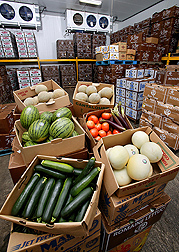This page has been archived and is being provided for reference purposes only. The page is no longer being updated, and therefore, links on the page may be invalid.
|
Read the magazine story to find out more. |
|
|
|
|
Science and Economics Both Work in Fruit Fly Program
By Kim KaplanFebruary 11, 2008
A research program to control exotic fruit flies in Hawaii has had an economic return of better than 30 percent. The Hawaii Area Wide Fruit Fly Integrated Pest Management (HAW-FLYPM) program is a cooperative effort of the Agricultural Research Service (ARS), the University of Hawaii Cooperative Extension and the Hawaii Department of Agriculture.
The HAW-FLYPM program developed a way to control four foreign fruit fly species—Mediterranean fruit fly, melon fly, oriental fruit fly and Malaysian fruit fly—that have been devastating more than 400 fruits and vegetables in the Hawaiian Islands for 100 years. Without the HAW-FLYPM program, farmers must rely on nearly weekly spraying of pesticides. Susceptible crops include citrus, tomato, guava, mango, melon, papaya and persimmon.
Within three years of the program's start, the researchers knew it worked scientifically and that growers could physically apply it for themselves. But for growers to continue with the program, real economic benefit needed to be demonstrated.
So the program brought in economist Andrew M. McGregor to conduct a cost-benefit analysis, totaling benefits to farmers, households, and the public. These benefits add up to a hefty 32 percent return on an investment of $14 million over 15 years.
For example, Aloun Farm in Oahu is now producing an additional 130,000 pounds of zucchini a year with minimal pesticide use, thanks to the HAW-FLYPM program, a gain of about $75,000.
The program has also helped preserve a Hawaiian cultural tradition.
Ipu, Hawaiian for the hard-shell gourd, has always been an important part of the island culture, used as a drum in hula dance and as a traditional way to store food or water.
But the melon fly had made it almost impossible to grow the traditional ipu gourds in Hawaii, and thousands of gourds have had to be purchased from California instead.
This past season, for the first time, the vice president of the Hawaii Gourd Society harvested hundreds of beautiful ipu gourds by using the HAW-FLYPM program.
Read more about this research in the February 2008 issue of Agricultural Research magazine.
ARS is the U.S. Department of Agriculture’s chief in-house scientific research agency.

